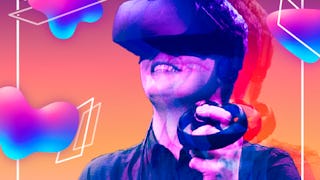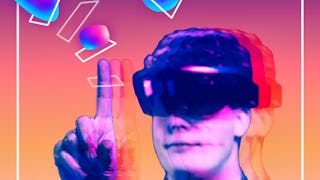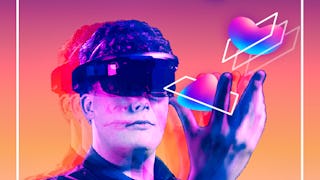This second course in the XR for Everybody specialization looks at how to design new user experiences for XR technologies. The course provides learners with a design thinking mindset and equips them with a fundamental toolbox for creating XR applications using rapid prototyping. It starts with a broad overview of the complete XR design process, discussing different paths to becoming an XR creator, what is generally involved in making XR experiences, and how to best get started. The course then emphasizes design thinking, critiques, and ethics while introducing guidelines and user-centered techniques like design jams. The second half of the course introduces a variety of methods and tools for prototyping both physically and digitally including on the XR devices themselves through immersive authoring.

Enjoy unlimited growth with a year of Coursera Plus for $199 (regularly $399). Save now.

User Experience & Interaction Design for AR/VR/MR/XR
This course is part of Extended Reality for Everybody Specialization

Instructor: Michael Nebeling
16,449 already enrolled
Included with
(176 reviews)
What you'll learn
Critique new and existing XR experiences from an ethical standpoint.
Create storyboards and physical prototypes of new XR experiences.
Create XR prototypes with digital and immersive authoring tools.
Infer technical requirements for implementing your XR prototypes.
Skills you'll gain
Details to know

Add to your LinkedIn profile
See how employees at top companies are mastering in-demand skills

Build your subject-matter expertise
- Learn new concepts from industry experts
- Gain a foundational understanding of a subject or tool
- Develop job-relevant skills with hands-on projects
- Earn a shareable career certificate

There are 4 modules in this course
This module will provide you with an introduction to XR design and development. When I say design, I usually mean user experience design or interaction design. Some designers have quite specific definitions of each of those terms, but I think of them broadly as forms of design focused on the creation of new user interfaces. While I think of many parts of this course as providing the theory and background to XR design, I will focus on the practical aspects of XR creation. I will start by making an analogy to filmmaking to establish key requirements, before going on to talk about the main steps part of a larger process and how to get started with doing XR. As we are just getting started, this first module does not have an honors track component associated with it. The honors track will start in the second module.
What's included
9 videos14 readings1 assignment3 discussion prompts
The second module will introduce you to design thinking and how common methods and techniques can be adapted for XR. This will help us build the right mindset for designing novel and compelling XR experiences. We will talk about building empathy with your users, ethical and responsible design, and best practices and design guidelines. I will also cover how to conduct and formulate design critiques in an effort to learn from existing interfaces. Finally, we will look at design jams as a way of solving design challenges collaboratively. Our first exercise in the honors track associated with this course will be a design critique of a VR or AR expedition as part of Google’s Expeditions XR app. You will be asked to develop one new idea that you will then take forward as you start prototyping your design concept next week.
What's included
17 videos11 readings1 assignment2 app items3 discussion prompts
We are moving from the conceptual to the practical, from thinking to doing. The next two parts of this course are dedicated to prototyping. In this first part on physical prototyping, I will emphasize paper a lot and also talk a lot about sketching. In my mind, brainstorming translates to sketching alternate ideas. Rather than creating, for example, a mind map, I sketch to ideate. This is a practice that I will emphasize. We’ll start flat on paper but will quickly become more physical using specific paper templates and dioramas. We’ll also see how to create mostly physical prototypes, but how to enhance them with AR techniques, to move closer to our envisioned final XR experience. In the honors track, you will have two major exercises. You will first create an XR storyboard based on the XR app you have previously critiqued. The design critique and storyboarding will help you develop a new idea of improving the existing XR interface. You will then prototype your design concept using physical materials including paper, cardboard, Play-Doh, and transparency. I hope you will appreciate the freedom and flexibility that physical prototyping gives you, allowing you to create a new XR experience without many of the constraints of digital tools.
What's included
10 videos11 readings1 assignment4 app items1 discussion prompt
The last module of this course will cover digital prototyping and user experience evaluation techniques for XR. While it is recommended to start prototyping on paper, it is crucial to experience a design concept for XR with XR technologies. I will introduce you to digital prototyping techniques as a way of increasing the fidelity of your prototype designs. You will learn about digital prototyping tools that support creating initial VR or AR experiences without the need for programming. Some tools support immersive authoring, which enables prototyping of XR experiences directly inside VR or AR. We will also learn about usability evaluation techniques and how to design and conduct a user study. Our final lecture will be on creating your XR portfolio as a way of effectively communicating and showcasing your design work. In the honors track, we will finalize our XR project with a digital prototype and submit our work for peer review. The peer review will not only provide important feedback on your work but also allow you to review and critique your peers’ work in a constructive way. I consider formulating good feedback and acting on critical feedback two vital skills for any designer but especially for those working in a space as rapidly evolving as XR.
What's included
11 videos9 readings1 assignment1 peer review2 app items2 discussion prompts
Earn a career certificate
Add this credential to your LinkedIn profile, resume, or CV. Share it on social media and in your performance review.
Instructor

Offered by
Explore more from Design and Product
 Status: Free Trial
Status: Free TrialUniversity of Michigan
 Status: Free Trial
Status: Free TrialUniversity of Michigan
 Status: Free Trial
Status: Free TrialUniversity of Michigan
 Status: Free Trial
Status: Free TrialUniversity of California San Diego
Why people choose Coursera for their career




Learner reviews
176 reviews
- 5 stars
77.27%
- 4 stars
14.77%
- 3 stars
5.68%
- 2 stars
1.70%
- 1 star
0.56%
Showing 3 of 176
Reviewed on Jan 12, 2023
It was lovely, hope i get time to complete honors track and upgrade my certificate.. it would have been better if the design digital tools were part of the course to learn from
Reviewed on Dec 29, 2021
very detailed, very good for those who are new to xR and or UX generally. Some great resources are provided.
Reviewed on Oct 27, 2023
I loved the course the instructor is really really nice and explain everything at a perfect pace.Motivates to complete the honors track aswell.

Open new doors with Coursera Plus
Unlimited access to 10,000+ world-class courses, hands-on projects, and job-ready certificate programs - all included in your subscription
Advance your career with an online degree
Earn a degree from world-class universities - 100% online
Join over 3,400 global companies that choose Coursera for Business
Upskill your employees to excel in the digital economy
Frequently asked questions
No. This course briefly reviews key concepts and technologies in XR. However, the first course in the specialization provides a stronger foundation. This course is focused on AR/VR design. It takes established principles, methods, and tools that you may be familiar with from traditional user experience and interaction design, which is often focused on web and mobile, and transfers that knowledge to XR.
No. This course is targeted at a broad audience. There are no programming exercises associated with it. A design background is useful but not required either. If you already have experience developing with XR technologies, this course will help you adopt a more user-centered approach.
No. To complete the main track of the course, it is recommended but not required. However, to complete the honors track, you will need access to AR/VR devices. To give AR a try, you need to have access to a smartphone. For VR, we do not recommend a particular device. It would be sufficient to use a Google Cardboard compatible display wrapper that turns your smartphone into VR goggles.
More questions
Financial aid available,
¹ Some assignments in this course are AI-graded. For these assignments, your data will be used in accordance with Coursera's Privacy Notice.

